

A new Ctenacanthus amblyxiphias discovery from the Permian of Kansas (when most of Kansas was covered by a much earlier ocean)
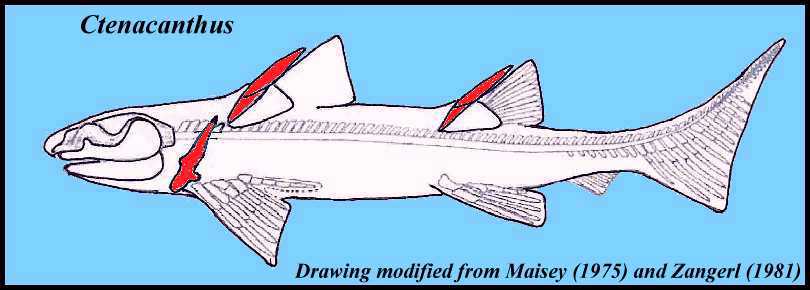
Page created 08/28/2002; Last updated 07/24/2009
The dorsal fin spines of Ctenacanthus sharks are found in marine deposits from Devonian through Permian time. As shown above, Ctenacanthids have a pair of rigid fin spines that emerge in front of each of two dorsal fins. The name Ctenacanthus literally means "comb-spine" and comes from the distinctive comb-like appearance of the two fin spines. The dorsal fin spines are ornamented with thin rows of dentine-like material that looks like strings of tiny beads in some areas. Ctenacanthid spines were sub-cylindrical and pointed and, in life, were supported by a wedge of cartilage that inserted into a groove on the posterior side of the fin spine.
Ctenacanthus Agassiz 1835 is part of the order Euselachii Hay (1902). According to Zangerl (1981, p. 51), "The Paleozoic members of this group are readily identified as having two dorsal fins, each preceded by a basically neo-selachian finspine whose apical end protrudes beyond the epidermis, and is finished by an outer coat of orthodentine that also forms the ornamentation (Maisey, 1975). Each spine is supported by a triangular cartilage piece that reaches into its central cavity from behind. The radials of the paired fins and the ventral lobe of the caudal fin are usually undivided transversally, and there is little difference in the size and robustness of the anterior and posterior radials. One anal fin is present. The shape of the body is fusiform. The integument is armored with placoid denticles and/or aggregates of modified lepidomorial denticles."
Wayne Itano provided the early identification of this specimen to species (Ctenacanthus amblyxiphias Cope 1891). For Cope's 1891 description and figures, and for more information about Ctenacanthus, go to the bottom of the page. The follow paper (abstract) was presented at the 135 Annual meeting of the Kansas Academy of Sciences (4th Annual Paleontology Symposium), at Pittsburg State University, Pittsburg, KS.
Since this page was first created, Keith Ewell has discovered a number of Early Permian ctenacanth spines and sharks teeth in Geary and Wabaunsee counties, near Manhattan, Kansas. See them here.
Everhart, M. J. and P. A. Everhart, 2003. First report of the Paleozoic shark, Ctenacanthus amblyxiphias Cope 1891 from the Lower Permian of Morris County Kansas. Kansas Acad. of Science Abstracts, 22:13. ABSTRACT In August, 2002, the remains of a small (1.6 m) Paleozoic shark (FHSM VP-15012) were discovered eroding from an exposure of the Grant Member of the Winfield Formation (Chase Group, Wolfcampian Series, Lower Permian) in the northeast corner of Morris County, Kansas. The matrix surrounding the specimen is a fine-grained, calcitic mudrock that is interpreted as a near-shore, shallow water deposit. The remains include the anterior and posterior dorsal fin spines, several pieces of calcified cartilage, including the left(?) scapulo-coracoid, placoid and ganoid scales, and placodont teeth. The nearly complete, anterior and posterior dorsal fin spines measure 25 and 18 cm in length. The fin spines are distinctively ornamented with thin rows of dentine-like material. The remains were identified as Ctenacanthus amblyxiphias by comparison with the dorsal fin spine described by Cope from the Redbeds (Permian) of Texas. Abundant shells of the brachiopod Composita subtilata, as well as silicified echinoid spines, ramose bryozoans, and crinoid fragments were associated with the remains. A crinoid calyx, provisionally identified as Delocrinus brownvillensis, was discovered nearby at the same stratigraphic level. A review of the literature and museum collections indicates that this is the first report of this shark species from Kansas. |
This webpage is a somewhat radical departure from the usual Late Cretaceous fossils normally featured on Oceans of Kansas. The much older Permian is well represented in Kansas, but is somewhat less fossiliferous than in other Midwest states such as Oklahoma and Texas. Go HERE for a map of the Earth during the Late Permian (large file- See the Paleomap Project for more paleo-maps of the Earth)
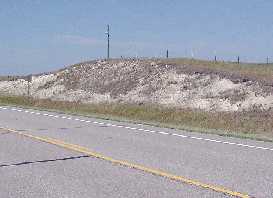 |
1) On August 17, 2002, my wife and I were returning from a meeting in Manhattan, Kansas when we decided to stop and prospect a road cut north of Herington (northwest corner of Morris County). I had been there twice before and knew that there were lots of invertebrate remains (mostly Composita brachiopods) weathering from an exposure of the Winfield Formation (Early Permian). The Winfield Fm. is part of the lower middle Permian Chase Group (Wolfcampian series) in central Kansas, and was deposited as limey bottom muds in the ocean that covered Kansas about 270 million years ago. The top of the underlying Doyle formation is exposed at the extreme left of the picture. The shark remains came from the Grant Member of the Winfield Fm. just to the left of center (A big "Thank You" to Dr. Salvadore Mazzullo at Wichita State University for the confirmation of the site stratigraphy). |
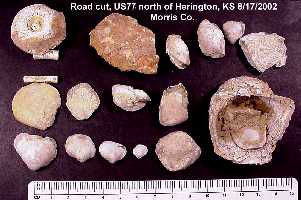 |
2) This is a representative sample of the
invertebrate remains, including a crinoid calyx, a single Reticulatia productid
brachiopod and multiple Composita subtilata brachiopods, that
I had collected earlier from the site. (Scale = mm). A larger picture of the Reticulatia
sp. shell is HERE. Note that there are at
least three small Composita brachs preserved inside the Reticulatia
shell. Other smaller invertebrate remains are shown HERE,
including echinoid spines, bryozoan fragments and crinoid stem fragments. Two larger pictures of the crinoid calyx are HERE and HERE (A "thank you" for the suggestion to Earl Manning and Peter Holterhoff.) Peter thought that the crinoid might be Delocrinus brownsvillensis or Arrectocrinus abruptus. |
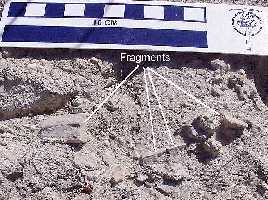 |
3) One of the first things I saw were fragments of what appeared to be bone on the surface of the weathered limestone. Bone or vertebrate remains of any kind are rare here. (Scale = cm) When I picked it up, I noticed that the fragments had a dentine-like coating on the surface. |
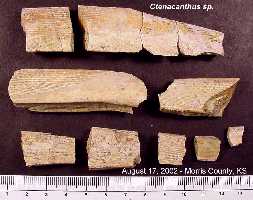 |
4) I recovered all of the readily visible float on the surface and took it home to see if I could identify it. It appeared to be from a fairly rare shark called Ctenacanthus, known mostly from the two dorsal fin spines that are usually the only remains preserved. From the fragments that I had picked up, it appeared that I had found at least the bases of both dorsal fin spines. The fresh breaks seemed to indicate that further fragments might still be at the site. (Scale = mm) |
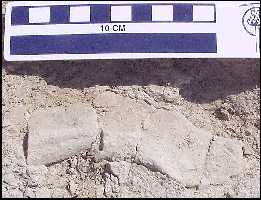 |
5) Two days later we returned to site better equipped for digging and screening the weathered limestone. One of the first things I found was a bone-like fragment that was still in place in the weathered limestone. |
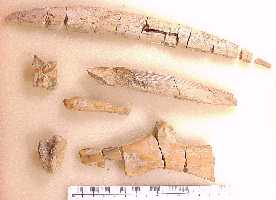 |
6) After returning home, screening and cleaning the surface material, we found that we had most of the remaining fragments of the two dorsal fin spines and what appeared to be additional calcified cartilage (scapulo-coracoid and a fin ray). Microscopic analysis located placoid scales from the shark. The two dorsal fin spines and the scapulo-coracoid are highlighted in red in the above drawing. (Scale = mm) |
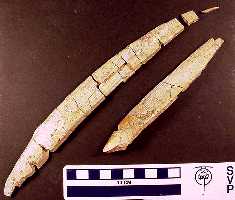 |
7) Another (left side) view of the anterior (left) and posterior (right) dorsal fin spines. The anterior spine is about 25 cm long. If this length is used to scale up the length of the fish from the above drawing, an estimated length of 1.6 m (5 ft) is obtained. (Scale = cm) |
 |
8) A cross section of the anterior dorsal fin spine. (Scale = mm) |
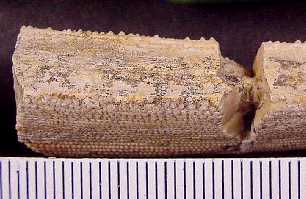 |
9) The posterior margin of the near-distal portion of the anterior dorsal spine showing characteristic posterior denticles. (Scale = mm) |
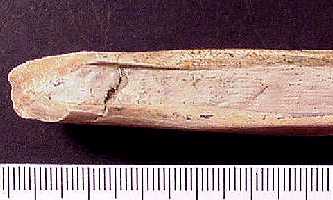 |
10) A posterior view of the anterior end of the posterior dorsal fin spine. (Scale = mm) |
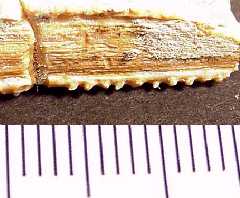 |
11) Another view of the 'teeth' (denticles) on the posterior side of the posterior dorsal fin spine. (Scale = mm) |
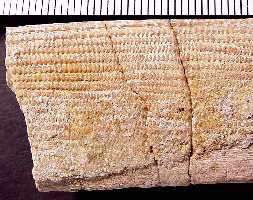 |
12) A close-up of the ornamentation on the right side of the posterior dorsal fin spine. (Scale = mm) |
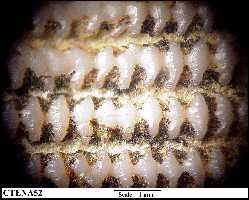 |
13) Detail of the ornamentation on the anterior end of the fin spine, near the insertion border. |
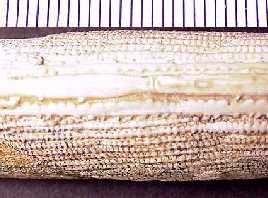 |
14) The anterior edge of the posterior dorsal fin spine. (Scale = mm) |
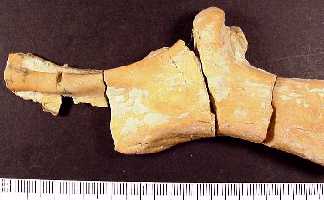 |
15) One of the scapulo-coracoids (pectoral girdle) of the shark. (Scale = mm). Two cross sections of the fragment on the right are shown HERE |
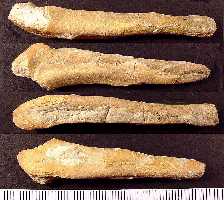 |
16) Four views of another unidentified piece of calcified cartilage - possibly a neural spine or a fin ray. (Scale = mm) |
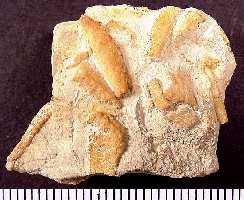 |
17) A fragment with a variety of calcified cartilage fragments and other structures, including placoid scales .... see micro-photographs below. (Scale = mm) |
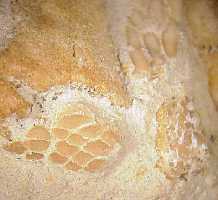 |
18) A micro-photograph of a group of placoid scales, showing the smooth lower sides. Other views are HERE and HERE. Approximate size of the group of scales in the lower left is 3 mm by 5 mm. Each scale would be about 1 mm in length. |
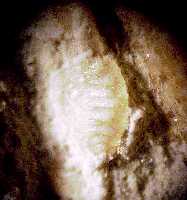 |
19) A micro-photograph of another group of placoid scales showing the 'spines' on the upper surfaces. Other views are HERE and HERE |
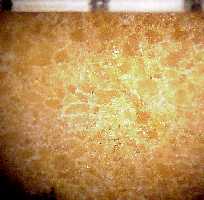 |
20) A micro-photograph of the surface of the scapulo-coracoid. The field of view in this picture is about 2 mm x 2 mm. The individual prisms of calcified cartilage are clearly visible. Another slightly different view is HERE. |
| 21) First pictures (added 8/31/2002) of the right side of the nearly complete dorsal fin spines. (Scale = cm) |  |
| 22) Left and right views of the posterior dorsal fin spine. (Scale = cm) | 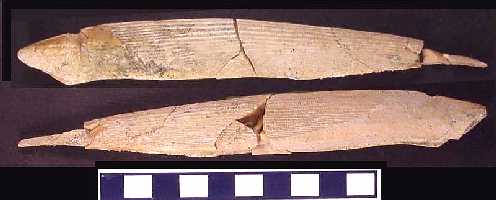 |
| 23) A posterior view of the tip of the posterior dorsal fin spine showing the posterior denticles. (Scale = mm) |  |
| 24) Recently recovered microscopic materials, including a broken tooth and a ganoid scale. A close-up photo of the broken placodont tooth is shown at far right. | |
| 25) Another broken tooth. This tooth is very similar to the Cladodus occidentalis tooth described from Kansas by Joseph Leidy in 1859 and figured in by him in 1873. (See bottom of page) | |
| 26) On October 18, we revisited the site again to pick up additional samples of the matrix and to search again for additional remains that might still be in the ground. As I looked around the surface of the site, I was pleased to find the remaining major piece of the anterior fin spine... sitting on top of a clump of small plants that had apparently sprouted under it. This fragment clearly shows the ornamentation that is present on both spines. | |
| 27) After we returned home, I fitted the new piece and several other, smaller fragments into the two fin spines. The result is a nearly complete pair of dorsal fin spines, the anterior 37% longer than the posterior one (26 vs. 19 cm). Also shown is one of the scapulo-coracoids, a unidentified cartilaginous spine and a piece containing numerous cartilage fragments and scales. The specimen has been donated to the Sternberg Museum and is curated as FHSM VP-15012. |
| 28) Further examination of the debris found in the matrix around
the specimen turned up some interesting microfossils, including this perfectly preserved
but tiny (1 mm) posterior "Maiseyodus johnsoni" tooth
(unpublished species name; Hansen, 1986). ID by Wayne Itano (9/2003). Far right: Fig. 18, from Hansen (1986), used with permission. |
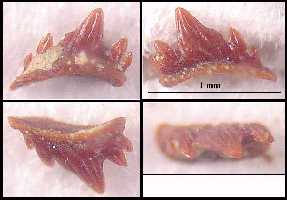 |
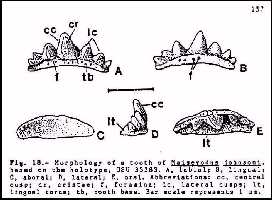 |
| 29) These microfossils may be teeth of a small, and apparently
rare, cladodont shark, identified as "Zangerlodus williamsi" (unpublished
species name; Hansen, 1986). ID by Wayne Itano (9/2003). (Click HERE for larger pic) Far right: Fig. 12, from Hansen (1986), used with permission (Scans courtesy of Wayne Itano) |
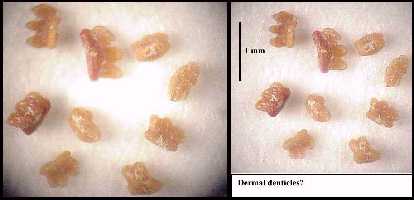 |
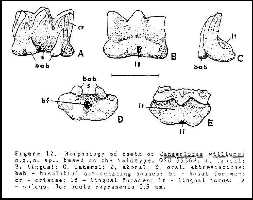 |
Published figures and descriptions:
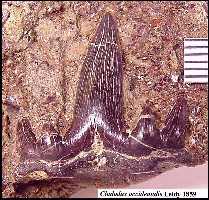 |
Shown here are two large teeth of the cladodont shark, Cladodus occidentalis Leidy 1859, from the Lower Permian of Wabaunsee County, Kansas. (Click to enlarge). See the ePaper (Leidy, 1859) here. | 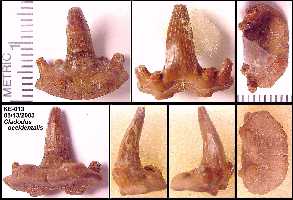 |
Other Ctenacanthus sites: Wayne Itano's discovery ------Dennis Murphy's site-------- The Earth History Portal
References:
Chorn, J. and D. Frailey, 1978. A large chondrichthyan spine, Physonemus mirabilis, from the Upper Pennsylvanian of Kansas, U.S.A. N. Jb. Geol. Paläont. Mh., (7):385-392, 1 fig.
Cope, E. D., 1891. Characters of Paleozoic fishes. Proc. U.S. Nat. Museum. 14:447-463. (Ctenacanthus amblyxiphias Cope 1891)
Everhart, M. J. and P. A. Everhart, 2003. First report of the Paleozoic shark, Ctenacanthus amblyxiphias Cope 1891 from the Lower Permian of Morris County Kansas. Kansas Acad. of Science (Abstracts), 22:13.
Hansen, Michael C., 1986, Microscopic chondrichthyan remains from Pennsylvanian marine rocks of Ohio and adjacent areas: unpublished Ph.D. dissertation, The Ohio State University, 535 p.
Hussakof, L., 1911. The Permian Fishes of North America, In Case, E. C., Revision of the Amphibia and Pisces of the Permian of North America. Carnegie Institute of Washington. (Ctenacanthus amblyxiphias Cope 1891)
Itano, W. M., K. J. Houck and M. G. Lockley, 2003. Ctenacanthus and other chondrichthyan spines and denticles from the Minturn Formation (Pennsylvanian) of Colorado. Journ. Paleon. 77(3):524-535.
Leidy, J., 1859. [Xystracanthus, Cladodus and Petalodus from the Carboniferous of Kansas]. Proc. Acad. Nat. Sci. Phila., 11:3.
Maisey, J. G., 1975. The interrelationships of phalacanthous selachians. N. Jb. Geol. Paläont. Mh. 9:553-567, 6 fig.
Maisey, J. G., 1977. Structural notes on a cladoselachian dorsal spine. N. Jb. Geol. Paläont. Mh. 1:47-55, 6 fig.
Maisey, J. G., 1982. Studies on the Paleozoic selachian genus Ctenacanthus No. 2. Bythiacanthus St. John and Worthen, Amelacanthus St. John and Worthen, Sphenacanthus Agassiz, and Wodnika Münster. American Museum Noviates, 2722:1-24.
Maisey, J. G., 1984. Studies on the Paleozoic selachian genus Ctenacanthus Agassiz. No. 3.: Nominal species referred to Ctenacanthus. American Museum Noviates, 2774:1-20.
Mazzullo, S. J., C. S. Teal, and C. A. Burtnett, 1997. Outcrop stratigraphy and depositional facies of the Chase Group (Permian, Wolfcampian) in Kansas and southeastern Nebraska. Kansas Geological Survey Technical Series 6, 210 p.
Romer, A. S., 1942. Notes on certain American Paleozoic fishes. Amer. Jour. Sci., 240:216-228, 1 pl.
St. John, O. A. and H. Worthen. 1875. Palæontology: Descriptions of fossil fishes. Geology and Palæontology, Part 2, Section 1, Geological Survey of Illinois, 6:245-532, i-vi, pl. 1-22.
Zangerl, R., 1981. Chondrichthyes I - Paleozoic Elasmobranchii. 3a:1-115 In Shultze, H-P. (ed.), Handbook of Paleoichthyology. Gustav Fischer Verlag, Stuttgart and New York.
Zidek, J., 1976. Oklahoma Paleoichthyology Part V: Chondrichthyes. Oklahoma Paleontology Notes, 36(5):175-192, Oklahoma Geol. Surv., Norman, OK.
Acknowledgments: A special "thank you" to Wayne Itano for the identification of the remains and a pre-publication copy of his new paper on Ctenacanthus in Colorado; to Larry Skelton of the Kansas Geologic Survey for the initial mapping and KGS road log information; to Dr. Salvadore Mazzullo (Wichita State University) for the stratigraphic information; to Earl Manning (Tulane University) for identification of the pectoral girdle and position of the two spines and the original calculations of the shark's length; and to Kenshu Shimada (DePaul University) and Bill May (Sam Noble Museum of Natural History) for providing copies of relevant reference materials.